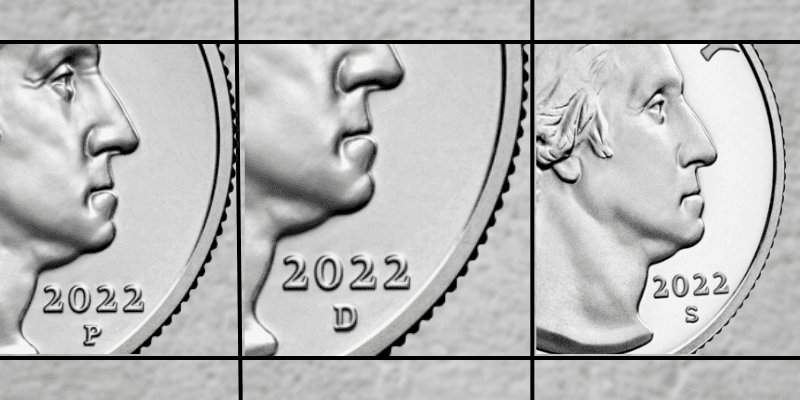Unveiling the Hidden Stories Behind Tiny Coin Markings
Imagine holding a coin that whispers secrets of its origin, a metallic messenger carrying tales from distant mints across generations. As a seasoned numismatist with decades of experience, I‘ve learned that mint marks are far more than simple letters – they‘re intricate historical narratives etched into metal.
The Ancient Origins of Mint Marks
Long before modern minting technologies, ancient civilizations understood the profound importance of identifying coin origins. In Ancient Greece, magistrates meticulously marked coins to ensure accountability and prevent counterfeiting. These early mint marks weren‘t just administrative annotations; they were declarations of economic integrity.
The Roman Empire elevated mint marking to an art form. Each coin carried unique identifiers revealing not just the mint location, but often the specific era, administrative region, and sometimes even the overseeing official. Imagine a coin that could tell you precisely where and when it was created – that‘s the magic numismatists like myself cherish.
The Evolution of Mint Mark Technologies
Mint mark creation has been a journey of incredible technological progression. In early periods, marks were hand-stamped, making each coin subtly unique. Skilled artisans would carefully impress mint marks using specialized tools, creating variations that today‘s collectors meticulously study.
By the medieval period, European mints developed more standardized techniques. The introduction of mechanical presses in the 15th and 16th centuries transformed mint mark production, allowing for greater precision and consistency. Each technological leap brought new complexities to coin production.
The United States Mint Mark Journey
The story of American mint marks is particularly fascinating. When the first national mint opened in Philadelphia in 1792, coins initially bore no mint marks. The assumption was that Philadelphia, as the primary mint, didn‘t require identification.
As the United States expanded westward and new mint locations emerged, the need for clear identification became crucial. Mints in Denver, San Francisco, Carson City, and New Orleans each developed unique marking practices, creating a rich tapestry of numismatic history.
Decoding Modern Mint Marks
Today‘s mint marks are precision-engineered symbols. Using microscopic engraving techniques, modern mints create marks that are not just identifiers but miniature works of art. Each mark represents a complex interplay of metallurgy, engineering, and historical tradition.
The Collector‘s Perspective: Why Mint Marks Matter
For collectors like myself, mint marks are more than administrative details – they‘re portals to understanding economic and cultural histories. A mint mark can transform an ordinary coin into a rare treasure, dramatically altering its value and significance.
Consider the 1894-S Barber dime – only 24 were minted in San Francisco that year. Today, these coins are worth millions, with their rarity directly tied to their mint mark. Such stories fuel the passion of serious collectors.
Rarity and Value: The Mint Mark Equation
Not all mint marks are created equal. Factors like:
- Total coins produced
- Historical context
- Preservation quality
- Unique minting circumstances
All contribute to a coin‘s collectible value. A mint mark isn‘t just a letter; it‘s a complex identifier of potential worth.
Technical Nuances of Mint Mark Identification
Authenticating mint marks requires sophisticated techniques. Modern numismatists use:
- High-resolution microscopy
- Metallurgical analysis
- Advanced spectroscopic techniques
These methods help distinguish genuine mint marks from sophisticated forgeries, protecting the integrity of coin collections worldwide.
Global Perspectives on Mint Marking
While our discussion has focused on American mint marks, the practice is global. From the intricate marks of the Royal Canadian Mint to the historical seals of European minting houses, each culture brings unique perspectives to coin identification.
The Future of Mint Marks
As digital technologies advance, mint marks may evolve. Microchips, laser etching, and blockchain technologies could revolutionize how we track and authenticate coins. Yet, the fundamental purpose remains unchanged: to tell a coin‘s unique story.
Practical Advice for Aspiring Collectors
For those drawn to this fascinating world, my advice is simple: approach collecting with curiosity and patience. Every coin has a story, and mint marks are your key to unlocking those narratives.
Invest in quality magnification tools, study historical references, and never stop learning. The world of numismatics is endlessly fascinating, with mint marks serving as your guide through historical landscapes.
Conclusion: More Than Just Letters
Mint marks represent humanity‘s enduring desire to document, authenticate, and celebrate our economic and cultural achievements. They are tiny time capsules, metallic memories of human ingenuity and craftsmanship.
As you hold your next coin, take a moment to examine its mint mark. You‘re not just looking at a letter – you‘re peering into a rich, complex history waiting to be discovered.
Happy collecting!
